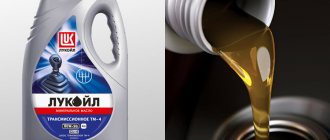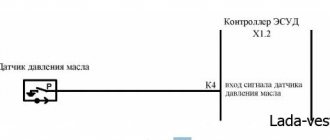What is oil used for?
Automotive oil ensures the proper functioning of various systems. It is used to reduce friction, cool, lubricate, transfer pressure to vehicle parts and components, and remove combustion products. The most difficult operating conditions occur with motor oils. They must not lose their properties in the event of instantaneous changes in thermal and mechanical loads, under the influence of atmospheric oxygen and aggressive substances resulting from incomplete combustion of fuel.
The oil creates an oil film on the surface of rubbing parts and reduces wear, protects against rust, and reduces the impact of chemically active components that arise during engine operation. By circulating in the engine crankcase, the oil provides heat removal, removes wear products (metal chips) from the contact zone of rubbing parts, and seals the gaps between the cylinder walls and piston group parts.
What is the difference between 5w30 and 5w40
As already mentioned, 5w40 oil is more viscous and less fluid at high temperatures. That is, when the piston passes, a thicker film remains on the cylinder walls than when using 5w30. This is the main difference between 5w30 and 5w40, since they behave the same at low temperatures. However, a thicker film is not always a plus.
Marking of 5w30 and 5w40 motor oil on a canister
What will happen if you use oil with a higher or lower high-temperature viscosity in the engine than indicated in the user manual:
- At higher viscosities, the film formed on the internal surfaces will be larger than required. In some places, lubricant simply may not flow due to too much viscosity. This is certainly bad: it can lead to premature wear of parts and an even greater increase in the operating temperature of the engine. Such troubles threaten if you pour 5w40 brand where 5w30 is recommended.
- In the opposite case (using 5w40 instead of 5w30), less lubricant is wasted. In principle, this lengthens the service interval, as some manufacturers and sellers of motor oils point out. But, if the car manufacturer recommended 5w40, then the 5w30 brand may form too thin a film on working surfaces. As a result, too rapid wear of the engine cylinder walls and piston rings may occur.
What is oil viscosity
Viscosity is the most important characteristic for motor oil, which changes depending on temperature. The oil should not be too viscous in cold weather so that the starter has the opportunity to turn the crankshaft and the oil pump has the opportunity to pump oil through the lubrication system. At high temperatures, the oil should not have low viscosity in order to create an oil film between the rubbing parts and provide the necessary pressure in the system.
Sulfated ash content
What determines the sulfate ash parameter
Sulfate ash content is the content in oil of various solid and inorganic compounds that are formed after combustion of the lubricant. Determined as a percentage of the total mass of the oil.
There are two concepts of ash content - base oil ash content and sulfate ash content. To explain it simply, the usual ash content indicates the purity of the base oil, that is, how much salts and non-combustible impurities are contained in the base itself without adding an additive package. Sulfate ash content is determined for ready-made oil with an added package of additives, and it determines the amount of additives and their composition, this applies to salts of sodium, potassium, phosphorus and other substances.
When considering the characteristics of an oil, the ash content must be as low as possible for it to be called quality. According to international requirements and standards, it should not exceed 2%.
Why is that? In any internal combustion engine, a certain amount of oil evaporates under the influence of high temperature, that is, it burns. This process leads to the fact that non-combustible impurities, which are always present in the oil, settle on the walls. That is, the higher the ash content of the oil, the more plaque there will be. Systems equipped with particulate filters are especially sensitive to high ash content; for them, only oils from the special LowSAPS category - low-ash oils - can be used.
How is the sulfate ash content of finished oil determined?
In the laboratory, oil is burned at a temperature of 775 degrees until solid residues form; it is this solid mass that is the same ash, non-combustible residues that settle on the walls of the engine and clog the exhaust gas cleaning system. The mass of residues is correlated with the amount of oil tested and the percentage is calculated.
If we talk about the ash content of a pure base, without additives, then it often does not exceed 0.005%, but in the finished oil we are talking about figures of 2%, this difference is made by the additives added to the oil. That is, we get the following picture: the “fatter” the additive package in the oil, the more ash there will be. So this indicator can be viewed in two ways. On the one hand, the oil must be clean and not leave deposits on the engine. On the other hand, high ash content indicates a rich additive package.
What does sulfate ash affect?
In addition to the fact that a high content of sulfated ash leads to a large amount of deposits inside the engine, it affects some other oil parameters. Ash content is directly related to the alkaline number of motor oil, which we will discuss below. The amount of ash is directly proportional to the amount of alkali, that is, the more ash, the more alkali and the higher the cleaning properties of oils.
The amount of ash deposits during combustion affects the flash point of the oil, which was already discussed above. This is especially noticeable in working out. Over time, additives burn out, and the less of them remain, the lower the flash point, that is, the performance of the oil decreases.
If we talk about the design of the car itself, then oils with a large amount of ash have a negative effect on the ignition system, make it difficult to start in cold weather, and contaminate the elements of the exhaust cleaning system - catalysts, particulate filters, EGR systems. Low ash oils, in turn, do not provide the necessary protection for loaded engines.
Classification of oils depending on the amount of sulfate ash
The ACEA classification pays great attention to the sulfate ash content of oils and even divides them into categories, depending on its content in the finished composition:
- Full Saps - full-ash lubricants, ash content is allowed within 1-1.1%.
- Mid Saps - medium ash lubricants, ash content allowed from 0.6 to 0.9%.
- Low Saps – low ash, less than 0.5%.
Manufacturers often place information on the oil canister about whether the oil belongs to a particular category.
Designation of motor oils according to the API standard
The API (American Petroleum Institute) standard specifies where the oil should be used. Consists of two Latin letters. The first letter S is a gasoline engine, C is a diesel engine. The second letter is the date of development of the car.
Gasoline engines:
- SC - cars that were produced before 1964;
- SD - cars that were produced 1964-1968;
- SE - copies that were produced in 1969-1972;
- SF - cars that were produced in the period 1973-1988;
- SG - cars developed in 1989-1994 for use in harsh conditions;
- SH - cars developed in 1995-1996 for harsh operating conditions;
- SJ - copies with a production date of 1997-2000, which have the best energy saving;
- SL - cars, with the beginning of production 2001-2003, and having an extended service life;
- SM - cars produced since 2004;
- SL+increased oxidation resistance.
For diesel engines:
- CB - cars manufactured before 1961, high sulfur content in fuel;
- CC - cars manufactured before 1983, operating in difficult conditions;
- CD - cars produced before 1990, which had to work in difficult conditions and a large amount of sulfur in the fuel;
- CE - cars manufactured before 1990 and the engine has a turbine;
- CF - cars produced since 1990, with a turbine;
- CG-4 - copies produced since 1994, with a turbine;
- CH-4 - cars manufactured in 1998, complying with toxicity standards applied in the USA;
- CI-4 - turbocharged cars with EGR valve;
- CI-4 plus - similar to the previous one, under high US toxicity standards.
Viscosity index value in summer and winter season
It is clear that the higher the oil viscosity index, the easier it is to start the engine on a cold winter night. That is why “synthetics” are better suited for winter use. As practice shows, there is a certain connection between the wear of engine friction pairs and the viscosity index. This is primarily due to starting wear. It is known that a significant portion of the wear of engine friction pairs “sits” in the cold start zone of the engine.
Until the oil, thickened in the cold, begins to be actively pumped through the channels of the lubrication system, the bearings and piston rings operate without lubrication.
The wear rate is an order of magnitude higher. And only after the oil temperature rises to a level where it becomes fluid, the friction pairs will go into normal operation. For oils with a high viscosity index, this moment will occur much faster, therefore the starting torture of the friction pairs will be shorter and softer.
This is what the viscosity-temperature characteristics of different types of motor oils look like. The black line is real “full synthetics” with a high content of PAO, the red line is typical HC synthetics, “hydrocracking” with 10% PAO, the green line is “semi-synthetics.” And all of them are “forty” according to SAE. The difference is only during start-up and warm-up, but this is important!
Kinematic and dynamic oil viscosity
To determine the quality of the oil, its kinematic and dynamic viscosity is determined.
Kinematic viscosity is an indicator of fluidity at normal (+40 oC) and high (+100 oC) temperatures. Determined using a capillary viscometer. To determine it, the time it takes for the oil to flow at given temperatures is calculated. Measured in mm2/sec.
Dynamic viscosity is an indicator that determines the reaction of a lubricant in a real load simulator - a rotational viscometer. The device simulates real engine loads, taking into account pressure in the lines and a temperature of +150 °C, and controls how the lubricating fluid behaves, how its viscosity changes precisely at moments of load.
Evaporation of NOACK masses
This indicator is defined as the amount of oil evaporated within 1 hour at a temperature of 250 degrees Celsius and a constant air flow. Measured as a percentage. The lower this indicator, the higher the stability of the oil at high temperatures and the lower its consumption. It is worth paying attention that NOACK depends on the viscosity of the oil; the higher it is, the lower the NOACK. In addition to viscosity, volatility is affected by chemical composition, surface adhesion, the presence of polymer thickeners, and more.
NOACK can be used to determine the quality of the oil; this indicator is limited by the requirements of international standards ACEA, API, and car manufacturer approvals. Using NOACK you can draw conclusions about the composition of the oil. But judging oil consumption by this indicator can only be indirect, since consumption depends not only on evaporation, but also on many factors.
Characteristics of automobile oils
- flash point;
- pour point;
- viscosity index;
- base number;
- acid number.
Flash point is a value characterizing the presence of light fractions in the oil, which evaporate and burn out very quickly, deteriorating the quality of the oil. The minimum flash point should not be lower than 220°C.
Pour point is the value at which the oil loses its fluidity. Temperature indicates the point at which the wax crystallizes and the oil completely hardens.
Viscosity index - characterizes the dependence of oil viscosity on temperature changes. The higher this indicator, the higher the temperature range of the oil’s performance. Products with a low viscosity index allow the engine to be operated only in a narrow temperature range. Because when heated they become too liquid and stop lubricating, and when cooled they quickly thicken.
The Base Number (TBN) indicates the amount of alkaline materials (potassium hydroxide) in one gram of motor oil. The unit of measurement is mgKOH/g. Present in motor fluid in the form of detergent dispersant additives. Their presence helps neutralize harmful acids and fight deposits that appear during engine operation. Over time, TBN drops. A large drop in the base number leads to corrosion and dirt in the engine crankcase. The most important factor in the drop in alkaline number is the presence of sulfur in the fuel. Therefore, oils for diesel engines, where sulfur is present in greater quantities, should have a higher TBN.
The acid number (TAN) characterizes the presence of oxidation products as a result of prolonged operation and overheating of the motor fluid. Its increase indicates a decrease in the service life of the oil.
Total Acid Number (TAN)
Acid is found not only in used oil; there are small amounts of acidic components in fresh oil and this is normal, due to the addition of active sulfur additives. Therefore, the technical characteristics of the oil and laboratory analyzes indicate the total acid number TAN.
The chemical acid components in the new oil are weakly acidic and do not have a negative effect on the engine metal. Most often they range from 1.5-3.0 mgKOH/g. When assessing the acid number in oil, we rely on the principle - the lower, the better. And pay attention to the amount of alkali. That is, if the oil has 8 alkali and 2 acid, it will work faster than one in which there is 10 alkali at 2 mgKOH/g acid.
The acid in fresh oil depends on the additive package; for example, the ZDDP anti-wear package produces quite a lot of acid. That is, the fatter the package, the greater the acidity will be and this is normal. The higher the mileage, the more acid is used, as discussed above.
Oil base and additives
Automotive oils consist of an oil base and additives. Additives are special substances that are added to oil to improve its properties.
The oil base is:
- mineral;
- hydrocracking;
- semi-synthetic (a mixture of mineral and synthetic);
- synthetic (directed synthesis).
In modern oils, the share of additives is 15-20%.
Based on their intended purpose, additives are divided into:
- detergents and dispersants - do not allow small residues (resins, bitumen, etc.) to stick together and, having an alkali in their composition, neutralize acids and do not allow sludge deposits to compact;
- anti-wear – create a protective layer on metal parts and, by reducing friction, reduce wear of rubbing surfaces;
- index - increase the viscosity of the oil at high temperatures, and increase its fluidity at low temperatures;
- defoamers - reduce the formation of foam (air-oil mixture), which impairs heat removal and the quality of the lubricant;
- friction modifiers – reduce the coefficient of friction between metal parts.
Compatibility: is it possible to add and mix 5W30 and 5W40?
In some emergency cases, it is urgent to add engine fluid to the engine. But it is not always possible to add exactly the lubricant that was poured initially. The same applies to the viscosity index.
Is it possible to mix 5W30 and 5W40 motor oils? You cannot mix synthetics and mineral water, or semi-synthetics with other types. Oils with different viscosity indices can be mixed provided that these lubricants are from the same manufacturer and have the same base. If the additives are different, unpredictable reactions may occur after mixing motor fluids with different viscosities.
Even if there are no visible consequences after mixing different motor fluids, you need to drain this mixture as soon as possible and replace the oil filter. Sometimes it may be necessary to flush the internal combustion engine before changing the engine fluid.
mix 5W30 and 5W40 oil, but for a short period of time (according to some experts, no more than 3 thousand km), with the same additives and from the same manufacturer. Also, original European oils that meet ACEA, SAE and API standards are always compatible (even when mixing synthetics with mineral).
Sources
- https://avto-moto-shtuchki.ru/avtotekhnika/52-markirovka-motornogo-masla-rasshifrovka.html
- https://oilspec.ru/vybor-masla/vyazkosti-masla-tablitsa
- https://unit-car.com/termini-i-sokrasheniya/191-vyazkost-masla-sae.html
- https://pomaslam.ru/harakteristiki/indeks-vyazkosti-masla.html
- https://maslo.expert/vyazkost/vjazkostnye-pokazateli-sae.html
- https://pomaslam.ru/motornye/maslo-5w30.html
- https://maslo.expert/vyazkost/5w30-harakteristiki.html
- https://maslo.expert/vyazkost/motornoe-maslo-5w-40-harakteristiki-rasshifrovka-vyazkost-temperaturnyj-rezhim.html
- https://AvtoNov.com/%D0%BC%D0%BE%D1%82%D0%BE%D1%80%D0%BD%D0%BE%D0%B5-%D0%BC%D0%B0% D1%81%D0%BB%D0%BE-5w30-%D0%B8-5w40-%D0%B2-%D1%87%D0%B5%D0%BC-%D1%80%D0%B0%D0% B7%D0%BD%D0%B8%D1%86%D0%B0/
- https://motorist.guru/sovety/motornoe-maslo-5w30-i-5w40-v-chem-raznicza.html
Mineral, synthetic and semi-synthetic motor oils
Oil is a mixture of hydrocarbons with a specific arrangement of carbon atoms. They can be connected in long chains or branched. The longer and straighter the chains of carbon atoms, the better the oil.
Mineral oils are obtained from petroleum using different methods:
- the simplest method is oil distillation with solvent extraction of raffinates;
- a more complex method is hydrocracking;
- Even more complex is catalytic hydrocracking.
Synthetic oil is obtained from natural gas by increasing the length of hydrocarbon chains. It's easier to get longer chains this way. “Synthetics” are of much higher quality than mineral oils, approximately three to five times. Its only drawback is its very high price.
“Semi-synthetic” is a mixture of mineral and synthetic oil.
A little bit of amateur performance
However, one question remains. How different are the performance characteristics of oils with the same viscosity, but from different manufacturers? This is a question that cannot be answered without laboratory tests. But many car enthusiasts, especially in cold regions, carry out their own measurements, constructing homemade devices for comparative determination of viscosity. The most obvious design seems to us to be a ball viscometer. The time it takes a steel ball to fall in a glass tube (the diameter of the ball is only slightly smaller than the diameter of the tube) filled with oil indirectly indicates the viscosity of the product. By the way, a similar principle is used in professional instruments, for example, in the Heppler viscometer. We made the same one. It will not be possible to measure exactly how many poises or centistokes are in an oil, but it allows you to visually compare the viscosity of several oils under identical conditions.
Engine oil viscosity at operating temperatures
Under high load conditions, the coefficient of friction increases and the temperature rises. Due to high temperature, the oil dilutes and the film thickness decreases. The friction coefficient decreases and the oil cools. That is, the temperature and film thickness vary within strictly defined ranges by the manufacturer. It is this mode that will allow the oil to fulfill its purpose well.
Consequences: what happens if you make the wrong choice?
- If you pour 5W30 instead of the recommended 5W40 lubricant, the low viscosity will reduce the thickness of the oil film. This will lead to increased load and friction between the units of the unit, which will lead to rapid wear (for example, cylinders and piston rings). Also, the waste of motor oil with index 30 is greater than with index 40, which means that 5W40 lubricant needs to be changed less frequently compared to 5W30.
- If you pour 5W40 instead of the recommended 5W30 lubricant, the oil wall will be thick, which will lead to the lubrication of all parts of the internal combustion engine components. But the oil distribution process will be difficult due to the increased viscosity. This will lead to an increase in friction force, an increase in temperature in the motor and accelerated wear of its components.
What happens if you don't change the engine oil?
What happens when oil viscosity is higher than normal?
If the viscosity is higher than normal, then even when the engine has already warmed up, the oil viscosity will not drop to the value calculated by the engineer. Under normal load conditions, the engine temperature will increase until the viscosity returns to normal. The conclusion follows from this - the operating temperature when using poorly selected engine oil will be constantly increased, which increases wear on engine parts and components.
Under heavy loads - during emergency acceleration or on a long steep climb, the engine temperature will rise even higher and may exceed the temperature at which the oil retains its operating properties. It will oxidize and varnish, carbon deposits, and acids will form in it.
Another disadvantage of too viscous oil is that part of the engine power will be lost due to high pumping forces in the system.
Explanation of the 5W30 marking
First of all, it should be noted that marking, which allows you to quickly determine the main characteristics of a lubricant, is carried out according to the generally accepted international SAE classification.
In accordance with this standard, for 5W30 motor oil, the first number “5” indicates the viscosity at low temperatures, and the second “30” indicates the fluidity parameter at low temperatures.
The product is all-season, which is why it is extremely popular among motorists. In fact, the versatility of the oil indicates its suitability for use in engines running on different types of fuel. And the temperature range of application covers almost all climatic zones of our country.
Advantages and disadvantages
Fully synthetic oil has excellent technical characteristics. 5W30 oil is ideal for cars operated in city driving conditions, when exposed to fairly aggressive external factors.
Motor oils of the 5W30 series have unique properties that are ensured by the introduction of a special multicomponent additive into the product composition.
These additives provide the highest level of enhanced protection of the power unit from premature wear, including:
- Anti-corrosion resistance;
- Resistance to oxidative processes;
- Excellent cleaning properties;
- High moisture release rates.
After pouring 5W30 oil into the lubrication system, a durable film that is resistant to various types of loads is formed on all moving and stationary parts of the engine. It provides the highest level of protection of parts from all kinds of loads.
And a fairly high level of viscosity is finely balanced with fluidity indicators. The result is that the power unit is reliably protected both during cold starts at low subzero temperatures and during operation at maximum load.
All of the above characteristics have ensured 5W30 fully synthetic motor oil increased popularity among a wide range of motorists. If used correctly, following the manufacturer's recommendations and observing all the basic application parameters, 5W30 oil has no disadvantages. Just like analogues!
What happens when oil viscosity is below normal
Oil viscosity below normal will not do anything good for the engine. The oil film in the gaps will be below normal and simply will not have time to remove heat from the friction zone. Therefore, oil will burn at these points under load. Burnout products and metal shavings in the gaps between the piston and cylinder can cause the engine to jam.
Too thin oil on a new engine, when the gaps are not yet too large, will work, but when the engine is no longer new, and the gaps themselves increase, the process of oil loss will accelerate.
A thin oil film in the gaps will not be able to provide normal compression and some of the gasoline combustion products will enter the oil. Power drops, operating temperature rises, and the process of abrasion and oil loss accelerates.
Such oils are used in special vehicles, the modes of which are designed to work specifically with these oils.
Which viscosity is most suitable for the engine
As a rule, most car enthusiasts believe that high viscosity at high temperatures is the best indicator. It especially warms everyone’s soul that such oils are used for sports cars. Alas, these indicators will not be able to turn an old loaf into a racing car, but the engine can be ruined by such a composition in a matter of days.
Experts recommend that you never fill the engine with oil whose viscosity does not meet the car manufacturer’s recommendations. The fact is that only the manufacturer is able to take into account the driving mode of a particular car and calculate the required oil viscosity.
And in order to finally convince drivers not to use “inappropriate” oil, an official experiment was carried out in 2008, the results of which later appeared on the pages of the famous magazine “Behind the Wheel”. One of the off-road racing participants poured high-temperature oil with a viscosity of 50 units into the engine of the once popular V8. As a result, the vehicle's performance dropped and engine wear increased significantly.
Results
Oils of the same viscosity grade, having the same specifications, made and based on the same oil base, generally do not interact aggressively. But if you do not want to have big troubles, it is better to add no more than 10-15% of the total volume. Soon after adding oil, it is better to change the oil completely.
Before choosing an oil, you should find out:
- vehicle release date;
- presence or absence of forcing;
- presence of a turbine;
- engine operating conditions (urban, off-road, sports competitions, cargo transportation);
- minimum ambient air temperature;
- degree of engine wear;
- degree of compatibility of the engine and oil in your car.
To understand when to change the oil, you need to focus on the documentation for the car. For some cars there are extended periods (30,000-50,000 km). For Russia, taking into account the quality of the fuel, operating conditions and harsh climate, it should be replaced after 7,500 - 10,000 km.
It is necessary to periodically monitor the quality and quantity of oil. Pay attention to its appearance. The mileage of the vehicle and the number of engine hours (running time) may not correspond to each other. While in a traffic jam, the engine operates in a thermally loaded mode, but the odometer does not spin (the car does not drive). As a result, the car did not travel very far, but the engine worked a lot. In this case, it is better to change the oil earlier, without waiting for the required mileage on the odometer.
Technical characteristics of 5W-40 - decoding
5W-40 is a multi-grade oil that must maintain fluidity at negative and positive temperatures within specified limits in order to qualify for this SAE class. As I have said in other articles, SAE can be an indicator of the climate in which the oil can be used, only partially and only in relation to the low temperature indicator. In general, this is an indication of the viscosity of the oil at different temperatures.
SAE 5W-40 viscosity values table:
| Characteristic | Index | Decoding |
| Pumpability | -35℃ | Minimum temperature at which oil is pumped through the channels |
| Turnability | -30℃ | The minimum temperature at which the engine can be started. |
| Kinematic viscosity at 100 degrees | 12.6-16.3 mm2/s | The indicator must be within these limits for the oil to be labeled 5W-40. |
| Kinematic viscosity at 40 degrees | 89-97 mm2/s | The same thing, but at a different temperature. This indicator is less important than viscosity at operating temperature. |
| Dynamic viscosity CCS at -30 degrees | No more than 6600 mPas | That is, the closer the indicator is to this limit, the worse the crankshaft will turn already at -30 degrees. |
| Flash point | From 224℃ | Can vary +/- 10-15 degrees. |
| Freezing point | About -45℃ | May vary. This indicator indicates the temperature at which the oil will completely freeze and will not be able to be pumped through the channels. |
From this table it is clearly seen that the second two symbols in marking 40 show what viscosity the oil will have exactly at operating temperature, that is, it indicates the thickness of the oil film and how easily and quickly the oil will pass through the system. It is very important to select this indicator according to the manufacturer’s recommendations, since different engines have different design features.
The first number 5 is an indication of low-temperature viscosity, that is, at -30℃ the oil will retain sufficient fluidity to crank the crankshaft.
According to GOST, the oil will be marked 3з/14. According to the API, it most often has a class SN, according to ACEA A1/B1 2010.
Benefits of SAE 5w-40 motor oils
5w-40 lubricant has gained high popularity due to its outstanding properties and unpretentiousness in relation to weather conditions. The additives used in synthetics of this viscosity provide the liquid with anti-corrosion, anti-acid and detergent properties. Compared to mineral-based lubricants, synthetic oils are able to perform excellently under significant temperature changes.
The 5w-40 product allows motorists to stand in traffic jams, drive off-road or on open roads with consistently high performance. The production of the liquid is carried out using the most advanced technologies, eliminating the collapse of the lubricant and engine breakdown. Manufacturers also subject their products to numerous tests and come up with the best formulas.
All formulations with a viscosity of 5w-40 have the following advantages:
- Ensuring efficient engine starting in cold weather.
- Increasing the resource of the power unit.
- High-quality enveloping of engine elements with a durable protective film, which is not permitted if all conditions of use are met.
- Resistance to oxidative processes and prevention of corrosion.
- Excellent cleaning properties that guarantee cleanliness of engine parts.
- No evaporation.
Synthetic, semi-synthetic, mineral water - which oil is better?
Mineral oil is a motor fluid made from petroleum products. As a result, this type of oil is divided into petroleum and paraffin oils. They have a certain fluidity, as well as a strict temperature regime, so these parameters can only be changed with the help of additives (due to which, by the way, the liquid quickly becomes unusable).
Synthetic oil is a more universal analogue of mineral oil, since synthetics are a product of the synthesis of certain chemical elements, and by changing its parameters, you can achieve almost any viscosity that is in demand on the automotive fluid market.
Semi-synthetic oil is a hybrid of synthetic and mineral oil. It has many advantages of both synthetic and mineral lubricants, but choosing the optimal one for a particular engine can sometimes be very difficult.
A significant difference between the three types of oils occurs only in winter, when synthetics greatly benefit. Due to its chemical structure, synthetic oil has good fluidity at low temperatures and also stabilizes engine performance. And besides this, it is almost not afraid of oxidation and “fade out” much longer.
GOST classification
At the beginning of the product code there is a letter M - it indicates that the oil is motor oil. Index 1 indicates oil for gasoline engines, 2 for diesel engines. The following number is assigned to the viscosity grade:
- Fractional codes, for example 63/14, mean that the oil is all-season;
- Markings 10, 12, 14, 20, 16, 24 are summer oil;
- 33, 6, 63, 43, 53 – winter oil.
Oil marked 8 is also all-season. The letter “Z” indicates that the mixture contains a thickening additive and is universal.
The letter index designates the engine group for which the use of engine oil is permitted:
- A – for diesel and gasoline non-boosted engines;
- B – for low-powered power plants;
- B – for medium-force;
- G – for highly forced ones;
- D – for highly accelerated power plants that are used in adverse conditions;
- D – for highly accelerated engines that are used in extreme conditions.
For example, the marking M-6з/10В means that the oil is universal for medium-boost engines, all-season.
How to choose the right engine oil
Automotive manufacturers indicate the recommended engine oil and its tolerances in the operating instructions. It is possible to select oil according to the same criteria, while remaining under warranty. With a competent approach to choosing oil, the characteristics of non-original oil will be in no way inferior to the original, and in some cases will exceed it.
Oils should be selected according to SAE (viscosity) and API classifications (by engine type and year of manufacture). Recommended tolerances for these classifications should be specified in the instructions.
Recommendations for selecting motor oil by viscosity:
- when the vehicle mileage is no more than 25% of the intended service life (new engine), it is required to fill in SAE 10W-40 or 5W-40 motor oils, regardless of the season;
- In a technically sound engine (mileage 26-74% of the intended service life), it is recommended to fill in motor oils with a viscosity of 10W-40, 15W-40 - in the warm season, with a viscosity of 5W-30, 10W-30 - in the cold season, regardless of the season – 5W-40;
- In an old engine (mileage more than 76% of the intended service life), it is necessary to fill in motor oils with a viscosity of 15W-40, 20W-40 - in the warm season, and 5W-40, 10W-40 - in winter, regardless of the season - 5W-40.
Specifics of various engines
Each piston internal combustion engine has manufacturer-defined tolerance standards for the gaps between the piston and the cylinder walls. These standards vary for engines with different compression ratios, piston strokes and displacements. This gap also takes into account the presence of a lubricating film of a certain thickness.
Kinematic viscosity of motor oil is another significant parameter standardized according to GOST 33-2000/ISO 3104-94. This physical quantity determines how quickly the lubricant will flow, resisting the forces of gravity.
What's the point of knowing how quickly the grease drains? In the internal combustion engines of some cars, lubricant is supplied to the cylinders due to its splashing by the moving crankshaft. If the oil drains too quickly, it will not provide an optimal protective film on the surfaces of moving parts. Kinematic viscosity is determined using a viscometer.
For motor oil, the kinematic characteristic is measured at temperatures of 40 and 100°C. It is possible to reliably establish fluidity properties only in laboratory conditions. Visually, you can only observe how the transparency of the oil changes during operation and its level - internal combustion engines in which it is consumed too quickly, becomes dirty and changes color require repair.










